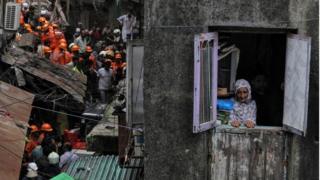Human chain to find Mumbai collapse survivors
A human chain of rescuers is searching for survivors a day after a building collapsed in the Indian city of Mumbai, killing 12 people and trapping dozens.
Officials say rescue efforts have been hampered by a warren of old streets which prevent access by heavy vehicles.
Among those who died in the collapse are three children. Nine other people were injured and are in hospital.
Such disasters are not uncommon in Mumbai, which has thousands of old, dilapidated buildings.
Rescuers are facing a huge challenge because Dongri – in the south of the city, where the building was located – is a web of cramped, narrow lanes, hemmed in by run-down buildings.
Officials say fire crews and ambulances could not even reach the site because the lane was too narrow. So they relied on a human chain of fire-fighters and local volunteers to get material to the building and carry the injured and the dead away from it.
“Tandel street, where the building stood, is so narrow that only one person can walk through it comfortably at a time,” says BBC Marathi’s Mayuresh Konnur.
Rescuers worked through much of the night looking for people trapped by the debris.
On Tuesday, fire-fighters were retrieving a body from the under the rubble when they discovered an outstretched hand. That’s how they found and saved 23-year-old Zinat Salmani and her daughter. She was trapped under an iron beam, wooden doors and a gas cylinder. They are now recovering in hospital.
Some 15 families were living in the Kesarbai building when it came down early on Tuesday, police said.
Peer Mohammed, who lives in the building next door, says he heard a huge sound about 11:40 local time (06:10 GMT).
“I ran outside and saw that people were stuck under the rubble. We rescued four people, but many others are still trapped, ” he told BBC Marathi’s Janhavee Moole.
Two of Mr Mohammed’s relatives – his brother and his brother’s daughter-in-law – died in the accident. Two other members of his family were injured.
Mr Mohammed, his family and his neighbours – many of whom live in Dongri’s crumbling buildings – are asking the same question. Who is responsible?
State housing minister Radhakrishna Vikhe Patil says there will be an inquiry into what caused the building to collapse and “strict action” will be taken against any officials who were found responsible for negligence.
The Kesarbai building is reportedly 100 years old.
While the cause in this particular instance still remains unclear, Mumbai administrators say the building’s owners added a section to the original structure illegally, without securing the necessary permits.
This, they say, is the part that collapsed, while the original building is largely still standing.
The ANI news agency has since shared a 2017 official notice from the Maharashtra housing and area development authority asking residents to evacuate the building for demolition.
Mr Mohammed confirms that such a notice was indeed issued in 2017. “But we need somewhere else to stay. We need help or where will we go with our family?”
This is a familiar story. Some 14,000 of Mumbai’s buildings are more than 70-80 years old. And they are especially vulnerable during the monsoon season, between June and September.
And dozens of them have collapsed in recent years, often during the monsoon season.
But occupants refuse to leave despite the threat of demolition or a possible collapse. Many of them have been living in the same place for generations and have nowhere else to go.
“Some provision should be made for maintaining old buildings,” says Harshad Bhatia, an architect and town planner. He says many old buildings have been declared “heritage” structures, increasing the bureaucratic hurdles standing in the way of renovation.
He adds that due to an archaic law which limits raising rents, owners cannot afford to invest in the upkeep of their buildings.
Source: Read Full Article



